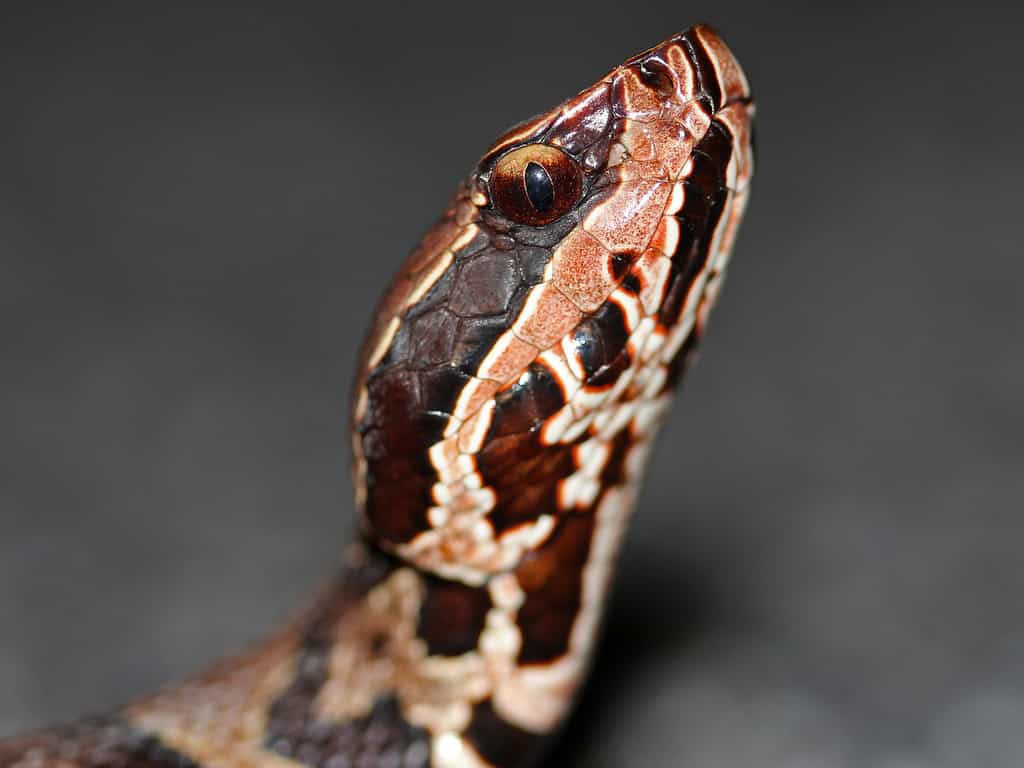
The post All the Brown Snakes You Can Find in Florida appeared first on A-Z Animals.
Things can get complicated when we refer to “brown snakes.” Brown snakes can mean snakes that are colored brown. However, brown snakes can also refer to the common name for non-venomous American brown snakes of the Storeria genus, which are endemic to North America and Central America. To make things even more complicated, if you’re not in North America, brown snakes may refer to snakes in the Pseudonaja genus. These snakes are highly venomous (such as the Eastern brown snake) and live in Australia, Papua New Guinea, and West Papua.
There are three species of American brown snakes (genus Storeria) that live in Florida. However, there are many more snake species in the state that are not commonly called “brown snakes”, but may show brown, tan, reddish-brown, or olive-brown coloration. Some of them are brown as adults, while others have brown patterns or brown coloring in their juvenile stage. Here we are looking at all of the brown-colored snakes in Florida, not just the common brown snake in the genus Storeria.
How Did We Come Up With Our List?
To find all the brown snake species that you may encounter in Florida, we first took a look at all of the native and non-native snakes in the state, according to the Florida Museum at the University of Florida, “Florida Snake ID Guide.” This guide lists 55 snakes. From there, we looked for all of the snakes that are either completely brown or have brown markings on their skin, whether as adults or during their juvenile stage. Check out the following list of Florida’s brown-colored snake species and subspecies.
Florida Cottonmouth (Agkistrodon conanti)

Although Florida cottonmouths are venomous, they are not aggressive and will try to flee before attacking.
©Ryan M. Bolton/Shutterstock.com
Sometimes referred to as a water moccasin, the Florida cottonmouth is a venomous snake around 30 to 48 inches long. These snakes have light to dark brown crossbands. However, as they age, the bands darken, and they may appear completely black.
Eastern Copperhead (Agkistrodon contortrix)

Eastern copperheads can grow to around 3 feet long.
©JWJarrett/iStock via Getty Images
This pit viper is a venomous snake that is easily identifiable by its hourglass pattern of light and dark brown crossbands. The Eastern copperhead is about 22 to 36 inches long and can only be found in the Florida panhandle. Newborn copperheads have bright yellow tips on their tails.
Boa Constrictor (Boa constrictor)

Native to Central and South America, boa constrictors are an invasive species in Florida.
©Alfredo Maiquez/Shutterstock.com
Although non-native, boa constrictors have been living and breeding in Florida since the 1970s, when people began keeping them as pets. Experts believe that some were either intentionally or accidentally released into the wild. Today, the only breeding population known in Florida is around the Charles Deering Estate in Miami. These large non-venomous snakes have brown and tan markings, and can grow up to 10 to 16 feet long.
North American Racer (Coluber constrictor)

North American racers can vary in color.
©Matt Jeppson/Shutterstock.com
As adults, many North American racers are black. But in their juvenile stage, they have gray bodies with reddish brown markings. North American racers are around 20 to 56 inches long and are non-venomous.
Eastern Diamond-Backed Rattlesnake (Crotalus adamanteus)

The venomous Eastern diamond-backed rattlesnake can reach up to 72 inches long.
©Donna Bollenbach/Shutterstock.com
This large pit viper only lives in the southeastern U.S. Eastern diamond-backed rattlesnakes are venomous snakes that range from 33 to 72 inches long. They can be identified by a row of diamond-shaped blotches with brown centers and cream borders. Their bodies are brownish, grey, or olive-green.
Timber Rattlesnake (Crotalus horridus)

Like all rattlesnakes, timber rattlesnakes sense their prey using heat-sensing pit organs located on their heads.
©Radiant Reptilia/Shutterstock.com
Timber rattlesnakes are venomous snakes that can vary greatly in color. They can be gray or light brown, with a long stripe down their body, which may be yellow, pink, black, or brown. They are around 36 to 60 inches long and are mainly found in northern Florida.
Rough Earthsnake (Haldea striatula)

Rough earthsnakes are some of the smallest snake species in Florida.
©Creeping Things/Shutterstock.com
These small snakes (about 7 to 10 inches long) are glossy brown to grayish brown in color. The rough earthsnake is non-venomous.
Eastern Hog-Nosed Snake (Heterodon platirhinos)

The Eastern hog-nosed snake will flatten its head to appear more threatening.
©Wxchsr/Shutterstock.com
Eastern hog-nosed snakes are non-venomous, about 20 to 33 inches long, and vary in color. They can be brown, tan, gray, olive, yellow, or reddish brown with dark brown blotches. They like to root around in the ground with their upturned snouts in their hunt for prey.
Southern Hog-Nosed Snake (Heterodon simus)

Southern hog-nosed snakes can puff up their bodies as a defense.
©Nathan A Shepard/Shutterstock.com
Also known as the puff adder, the Southern hog-nosed snake will hiss and puff up its body as a defense. Despite their frightening appearance, they are non-venomous. They are about 18 to 22 inches long and can vary in color, including yellowish-brown, tan, gray, or orange.
Brahminy Blindsnake (Indotyphlops braminus)
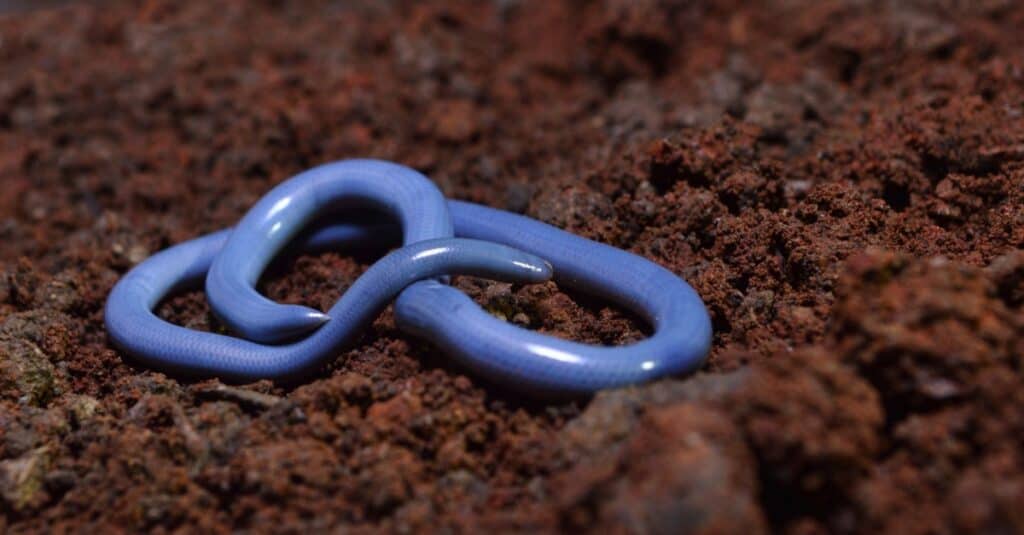
The tiny Brahminy blind snake can vary in color, with some appearing as dark brown.
©RealityImages/Shutterstock.com
Brahminy blindsnakes range in color from dark brown to black to yellowish brown to gray. They are small snakes, reaching about 4.4 to 6.5 inches in length. They are non-venomous and non-native to Florida. Experts believe they came to the U.S. on the soil of potted plants.
Florida Kingsnake (Lampropeltis floridana)

The Florida kingsnake lives in southern Florida.
©Patrick K. Campbell/Shutterstock.com
Florida kingsnakes are non-venomous and around 36 to 48 inches long. Their color can vary from brown to yellow with yellowish crossbands.
Apalachicola Kingsnake (Lampropeltis meansi)
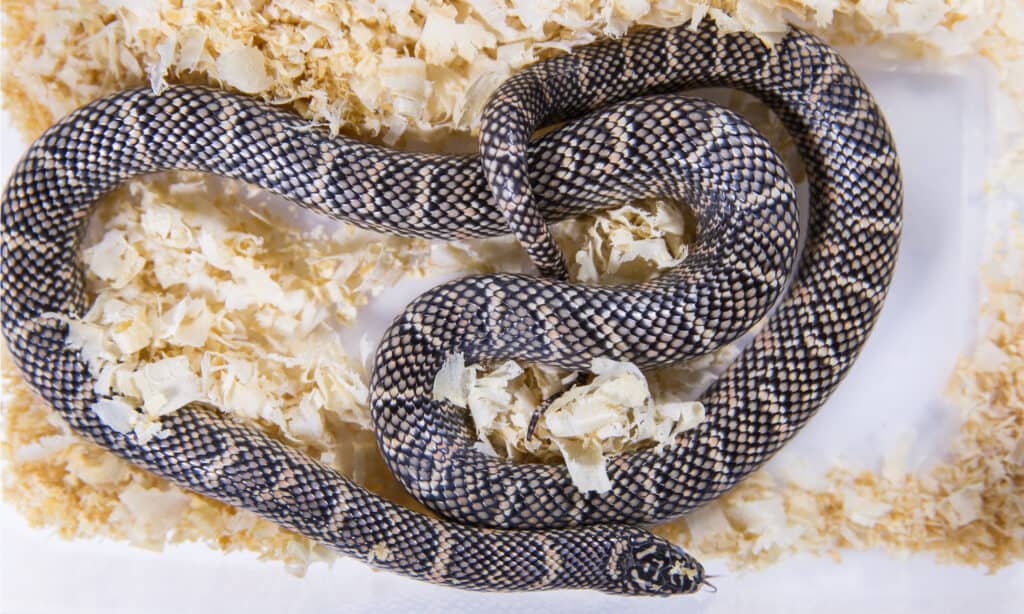
Apalachicola kingsnakes can be found in the Apalachicola Lowlands in Florida.
©Left Handed Photography/Shutterstock.com
The Apalachicola kingsnake is typically black to dark brown. These non-venomous snakes are about 36 to 48 inches in length.
Striped Swampsnake (Liodytes alleni)

The striped swampsnake primarily eats crayfish.
©Matt Berger, CC BY 4.0, via Wikimedia Commons – Original / License
Striped swampsnakes are brownish-yellow and have dark stripes running the length of their body. Also known as the striped crayfish snake, they are around 13 to 20 inches long.
Glossy Swampsnake (Liodytes rigida)

Also known as the crayfish snake, glossy swampsnakes primarily eat crayfish.
©Radiant Reptilia/Shutterstock.com
The glossy swampsnake has shiny scales of a brown to olive brown color. They are around 14 to 24 inches long and are non-venomous.
Eastern Coachwhip (Masticophis flagellum flagellum)
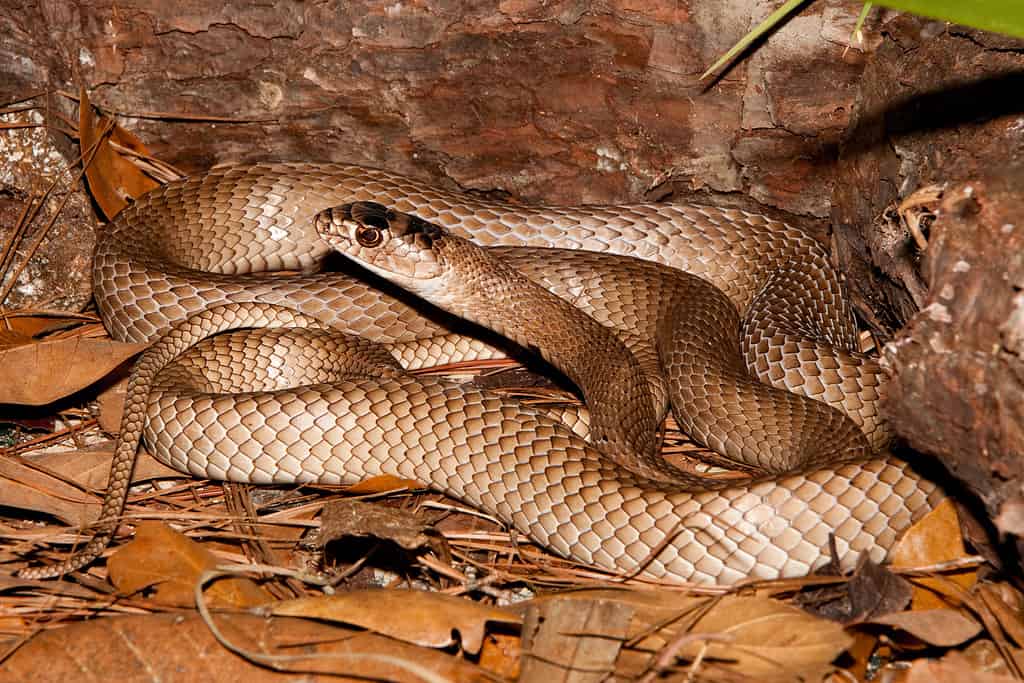
Eastern coachwhips are large snakes that can reach up to 5 feet long.
©Jay Ondreicka/Shutterstock.com
The Eastern coachwhip (a subspecies of the coachwhip snake) is around 42 to 60 inches long and has a tan body with a darker brown head. They are non-venomous and can be found across mainland Florida, but not in the Florida Keys.
Saltmarsh Snake (Nerodia clarkii)
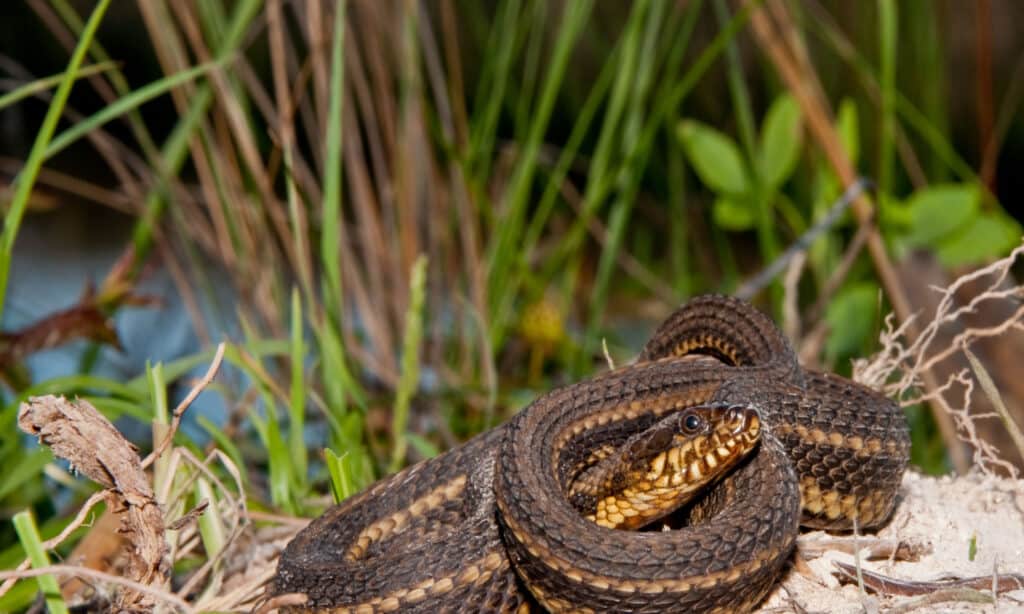
The largest salt marsh snake on record was 36.7 inches long.
©Jay Ondreicka/Shutterstock.com
Also known as the saltmarsh watersnake, the saltmarsh snake varies in color, including gray, orange, black, brown, and tan. They are typically around 15 to 30 inches, although the largest on record was 36.7 inches long.
Mississippi Green Watersnake (Nerodia cyclopion)

Mississippi green watersnakes are semi-aquatic and can reach 30 to 55 inches in length.
©Jason Patrick Ross/Shutterstock.com
Although it’s named the Mississippi green watersnake, these non-venomous snakes can be deep olive or brown. They are rare in the state and have only been seen in the far western panhandle.
Plain-Bellied Watersnake (Nerodia erythrogaster)
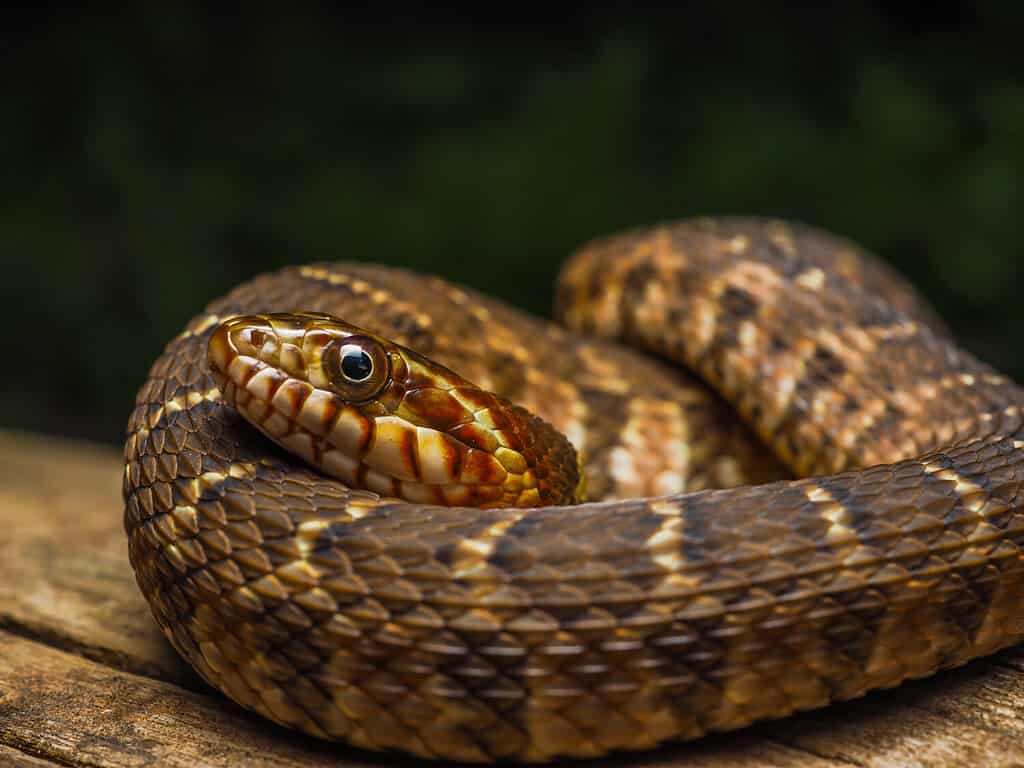
Plain-bellied watersnakes are nonvenomous.
©Tyler Albertson/Shutterstock.com
These non-venomous snakes are about 30 to 48 inches long and are found around bodies of water in the Florida panhandle. Plain-bellied watersnakes are typically gray, light brown, or dark brown.
Southern Watersnake (Nerodia fasciata)
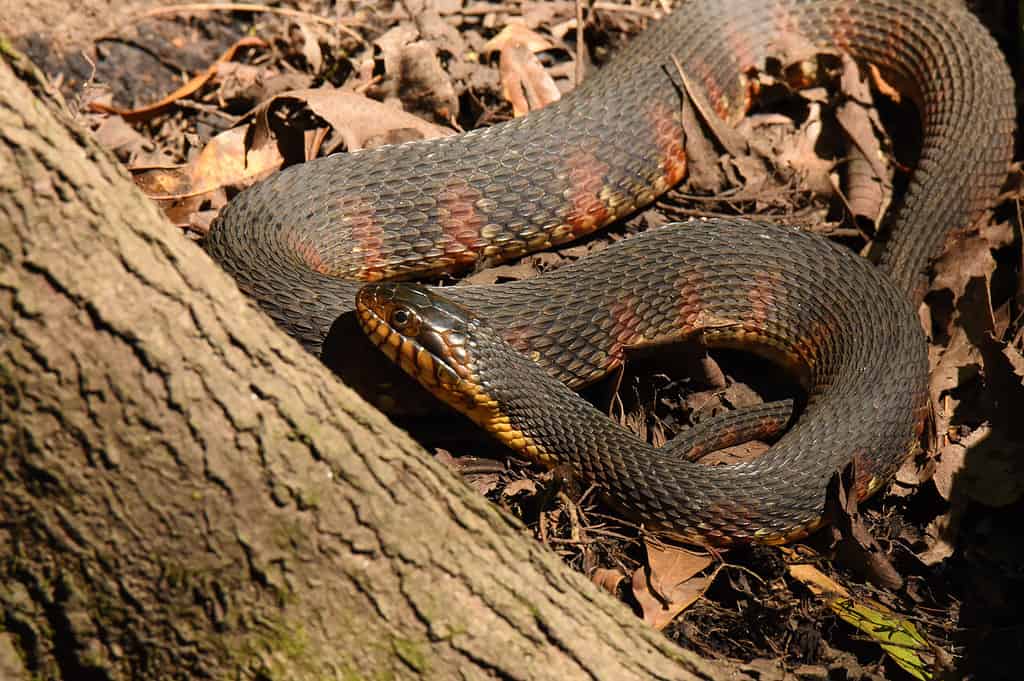
Like other watersnakes, southern watersnakes give birth to live young.
©Gilbert S. Grant/Shutterstock.com
Also known as the banded watersnake, or Florida watersnake, the southern watersnake’s background color may be red, brown, olive, or grey, with dark brown crossbands. These non-venomous snakes are around 22 to 42 inches long.
Florida Green Watersnake (Nerodia floridana)

The Florida green watersnake is one of the largest watersnakes found in North America and can reach 30 to 55 inches in length.
©A. Viduetsky/Shutterstock.com
The non-venomous Florida green watersnake lives throughout mainland Florida but isn’t found in the Keys. These snakes can be brown, greenish-brown, or orange in color.
Midland Watersnake (Nerodia sipedon pleuralis)

Midland watersnakes prey on fish and amphibians.
©damann/Shutterstock.com
You will only find midland watersnakes in Florida within the western panhandle. They are around 24 to 30 inches long and are light brown with darker crossbands.
Brown Watersnake (Nerodia taxispilota)
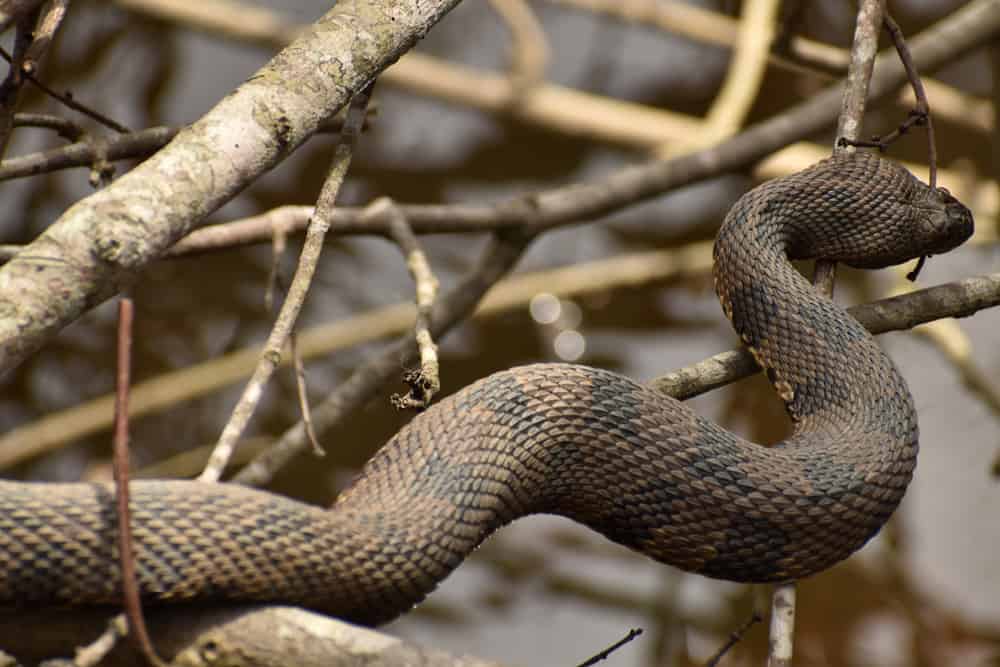
The brown watersnake lives in bodies of water throughout Florida.
©Jstengel/Shutterstock.com
The brown watersnake is in the same genus (Nerodia) as the southern watersnake. These non-venomous snakes range in size from about 30 to 60 inches in length. Brown watersnakes have tan bodies with dark brown blotches. You can find them in bodies of water throughout Florida, except in the Keys.
Eastern Ratsnake (Pantherophis alleghaniensis)

The Eastern ratsnake may be large, but it has a shy disposition.
©Jay Ondreicka/Shutterstock.com
Eastern ratsnakes can vary in color, with some appearing brown. Juveniles have grey and brown blotches over their tan body. Also known as chicken snakes, Eastern ratsnakes are around 42 to 72 inches long and are non-venomous.
Red Cornsnake (Pantherophis guttatus)

Also known as chicken snakes, red cornsnakes live in the southeastern U.S., including Florida.
©Scink/Shutterstock.com
Red cornsnakes may also be known as chicken snakes, red ratsnakes, or Eastern cornsnakes. These non-venomous snakes are about 30-48 inches long and are orangish-brown with orange, red, or brown blotches.
Eastern Pinesnake (Pituophis melanoleucus)
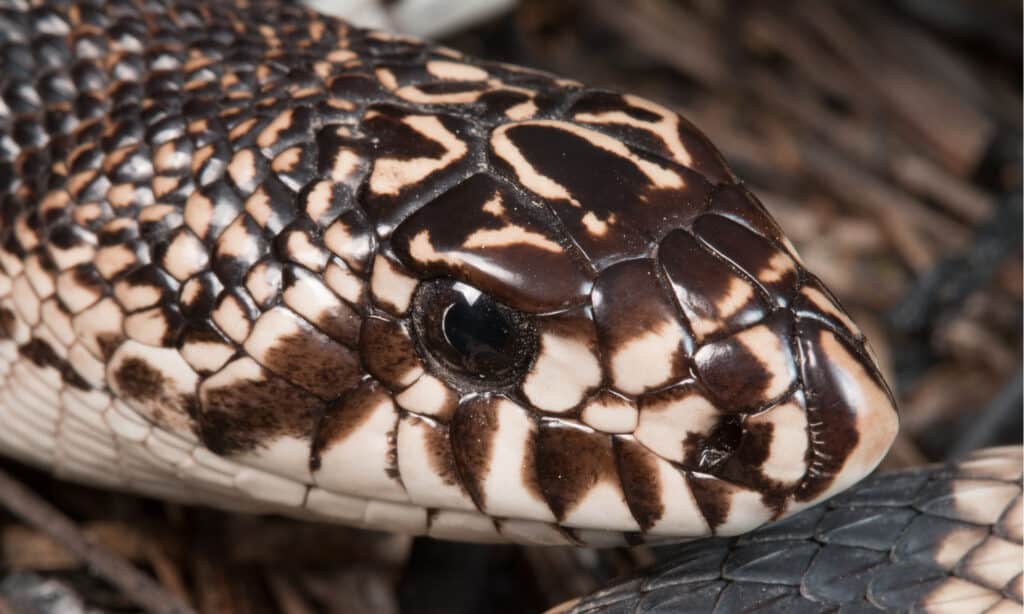
Eastern pinesnakes eat a diet of rodents, lizards, small mammals, birds, and eggs.
©Nathan A Shepard/Shutterstock.com
Sometimes known as the Florida pinesnake, the Eastern pinesnake is around 48 to 66 inches long. These non-venomous brown snakes have reddish brown or dark brown blotches.
Burmese Python (Python bivittatus)
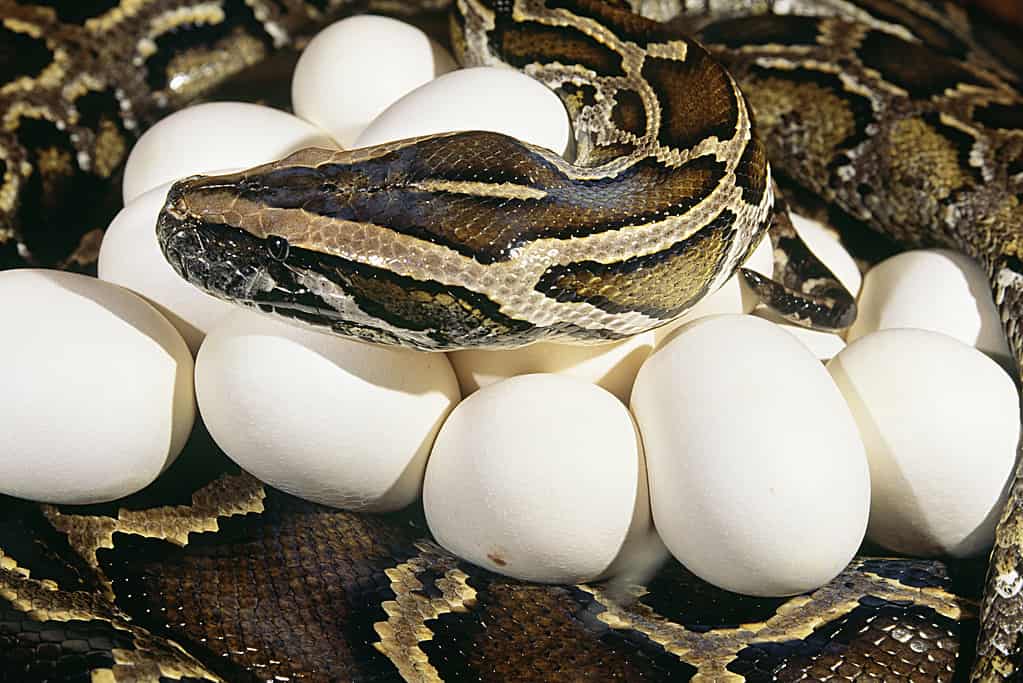
Although Burmese pythons live in Florida, they are native to Southeast Asia.
©Paul Tessier/Shutterstock.com
Burmese pythons are not native to Florida but were introduced as released pets in the 1970s and 1980s. They are non-venomous and are brownish-gray in color with reddish-brown or brown patterns.
African Rock Python (Python sebae)
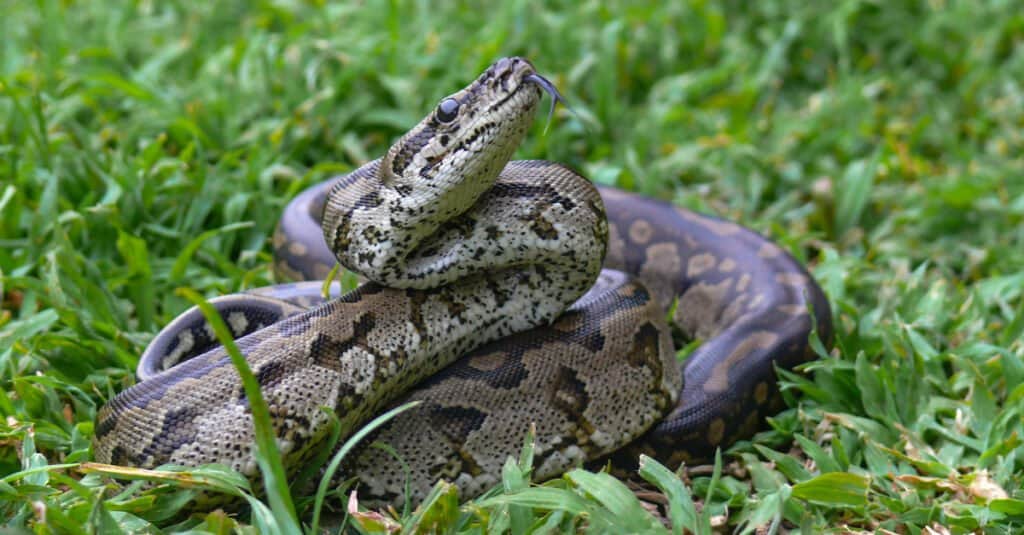
Rock pythons are native to sub-Saharan Africa, but now live in the Everglades region of Florida.
©Chris Graf/Shutterstock.com
African rock pythons are not native to Florida, but come from sub-Saharan Africa. They were first discovered living in Florida in the early 2000s. These large snakes are 10 to 16 feet long and usually brown to tan colored with dark blotches.
Queensnake (Regina septemvittata)
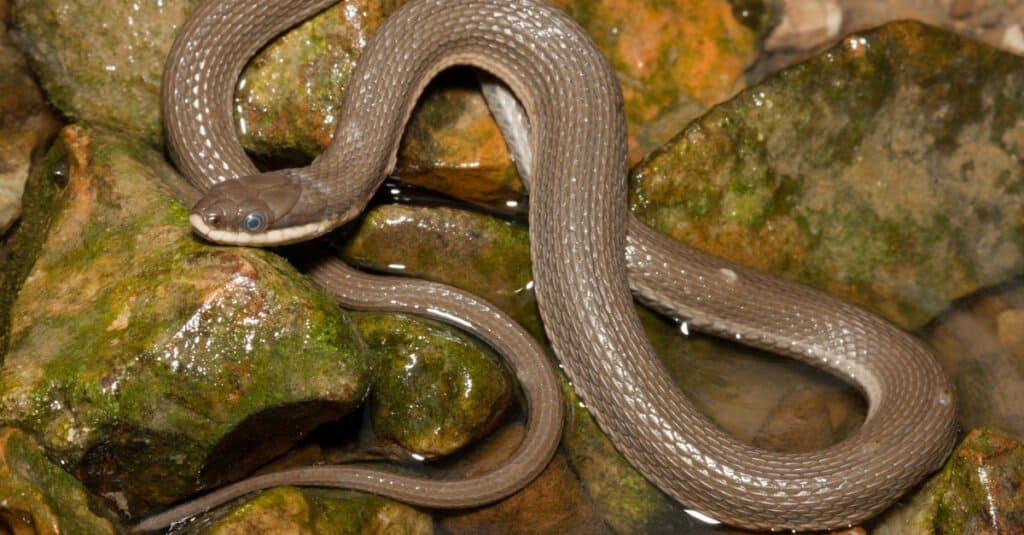
Queensnakes prefer to eat freshly molted crayfish to avoid having to digest the hard exoskeleton.
©Nathan A Shepard/Shutterstock.com
The non-venomous queensnake is about 15 to 24 inches long and is olive green to brown in color. However, the largest on record reached a length of 37 inches.
Pine Woods Littersnake (Rhadinaea flavilata)
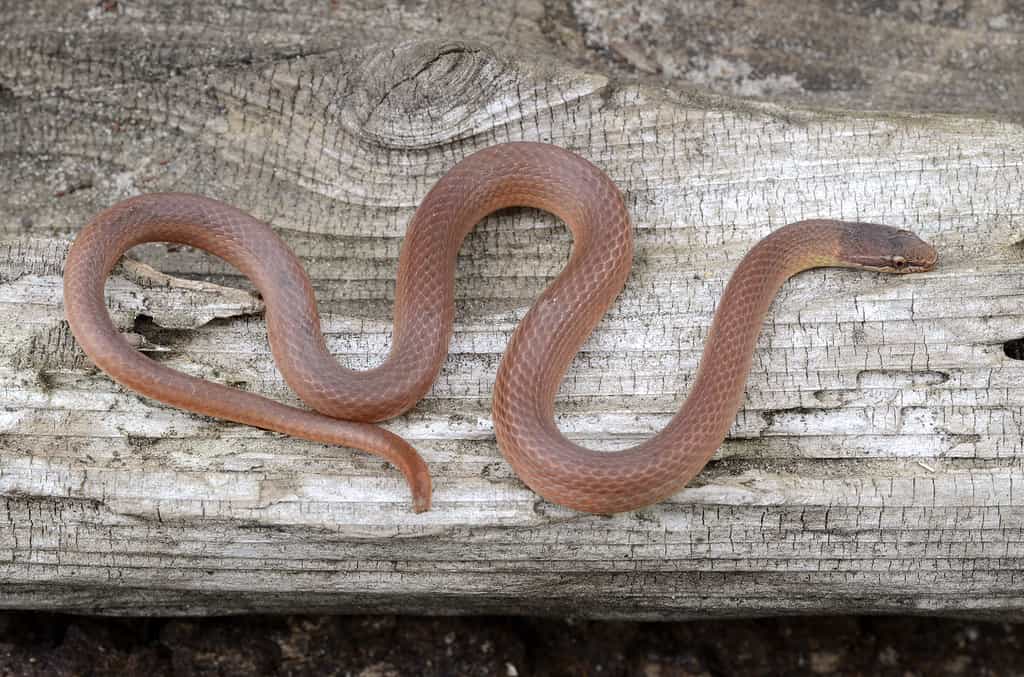
Pine woods littersnakes are nocturnal and prey on small lizards and amphibians.
©Patrick K. Campbell/Shutterstock.com
These small non-venomous snakes are only about 10 to 13 inches long. While some are reddish-orange, they may also be colored reddish-brown. They are also known as the yellow-lipped snake or the brown-headed snake.
Dusky Pygmy Rattlesnake (Sistrurus miliarius barbouri)

When this small rattlesnake shakes its tail, it sounds less like a rattle and more like a buzzing sound.
©Kristian Bell/Shutterstock.com
While its body is gray, the dusky pygmy rattlesnake has a reddish-brown stripe that runs down its back. These venomous snakes are around 12 to 24 inches long. They have a slender tail that ends in a rattle, and are a subspecies of the pygmy rattlesnake.
DeKay’s Brownsnake (Storeria dekayi)
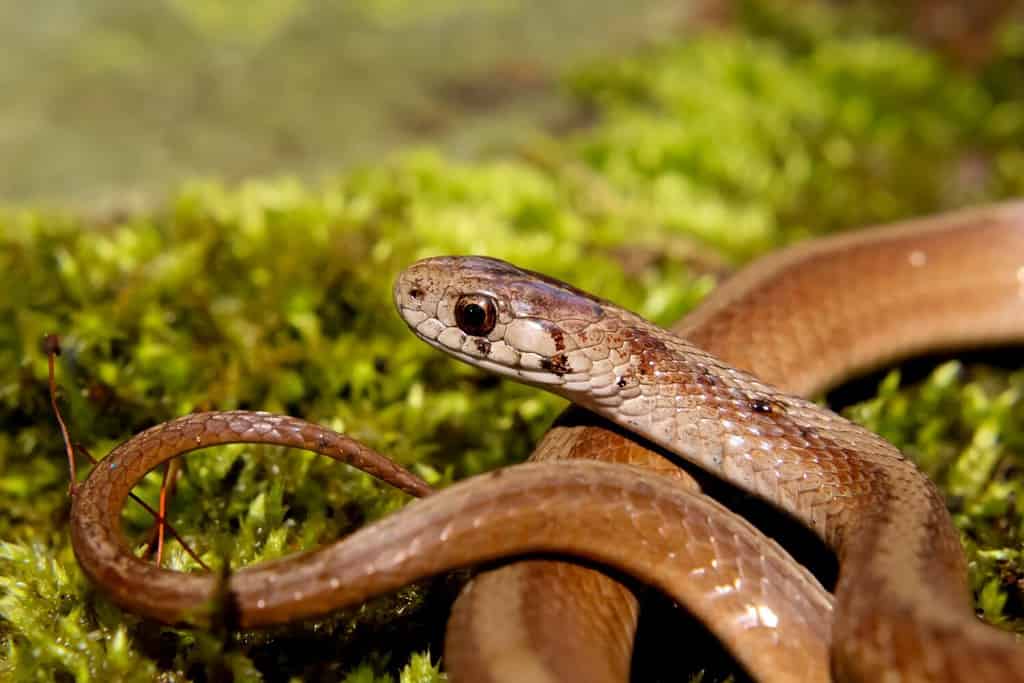
Don’t worry if you see a Dekay’s brownsnake in your garden, as this snake will feed on slugs, snails, and grubs.
©Christopher Troll/Shutterstock.com
This brown-colored snake is one of three species of American brown snakes in the genus Storeria that live in Florida. Dekay’s brownsnakes are small snakes about 9 to 13 inches long and can be found in Florida’s panhandle.
Red-Bellied Snake (Storeria occipitomaculata)
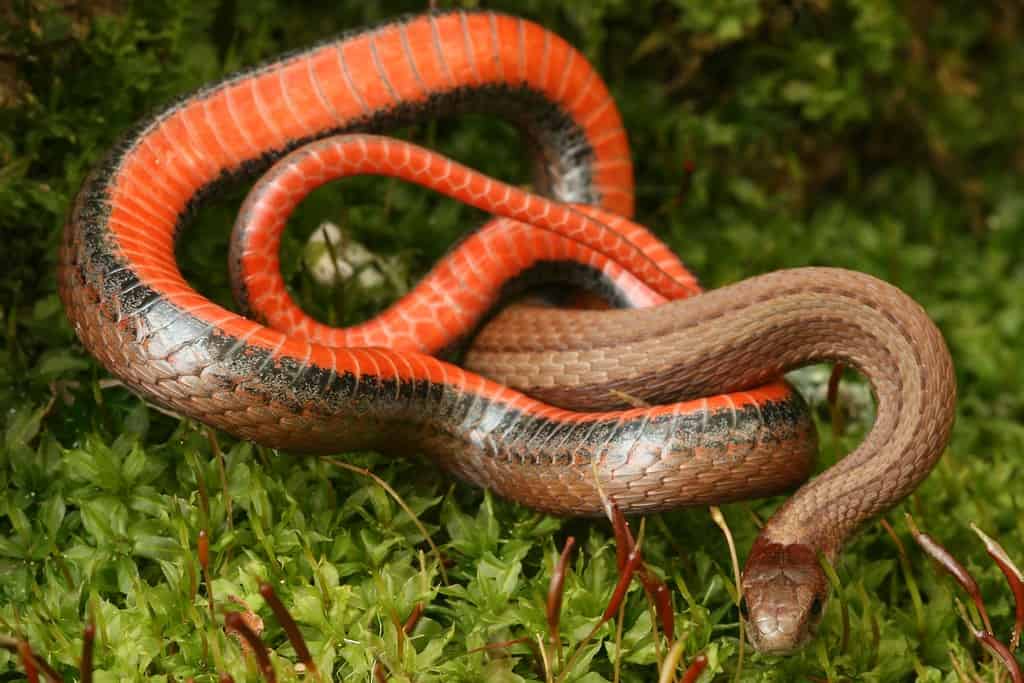
Red-bellied snakes are brown with distinctive red undersides.
©Kevin Collison/Shutterstock.com
Another snake species in Florida in the Storeria genus is the red-bellied snake. Red-bellied snakes, as their name suggests, have red stomachs. The rest of the snake can be colored brown or black. They are small, slender snakes, and only reach about 8 to 10 inches long.
Florida Brownsnake (Storeria victa)
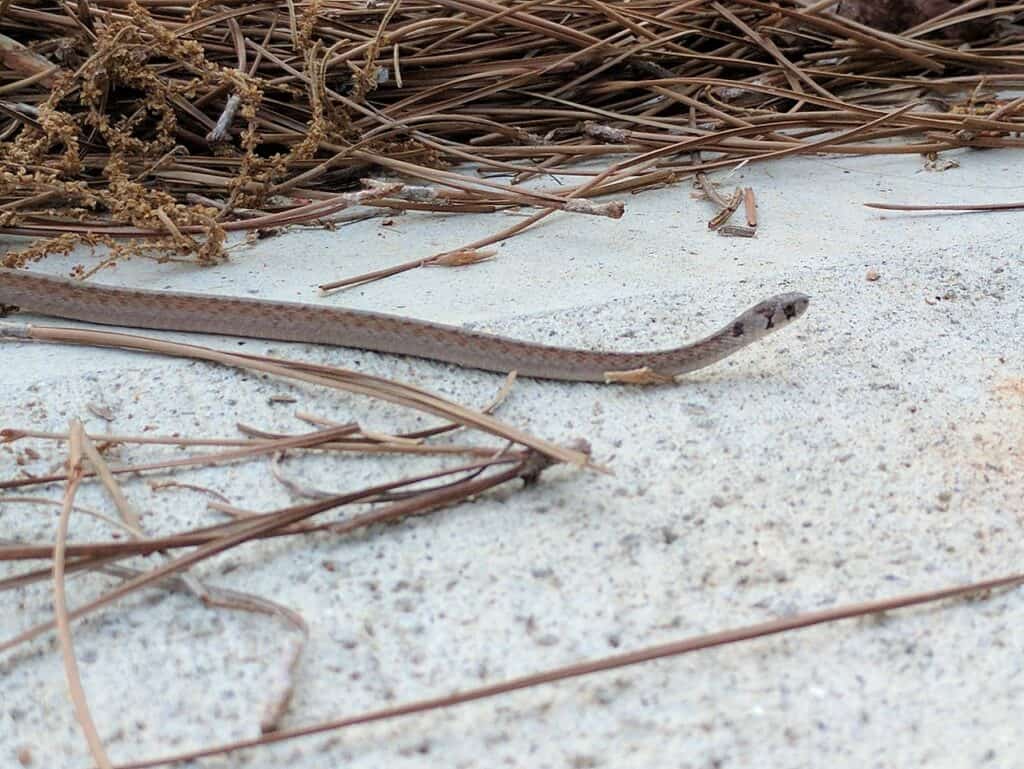
Florida brownsnakes can only be found living in Florida and Georgia.
The third true brownsnake on our list is the Florida brownsnake. These little snakes are around 9 to 13 inches in length. They are non-venomous and live in the Florida peninsula.
Southeastern Crowned Snake (Tantilla coronata)

You may not easily spot the Southeastern crowned snake, as they prefer hiding under leaf litter and logs.
©Gino Caccese/Shutterstock.com
These small non-venomous snakes are around 8 to 10 inches as adults. Southeastern crowned snakes can be tan to reddish brown in color and are typically found in the panhandle.
Rim Rock Crowned Snake (Tantilla oolitica)

Rim rock crowned snakes are named after the Miami Rim Rock land arrangement where they live.
Another small snake, rim rock crowned snakes are only 7 to 9 inches long. These non-venomous snakes can be tan or light brown with a darker head.
Florida Crowned Snake (Tantilla relicta)
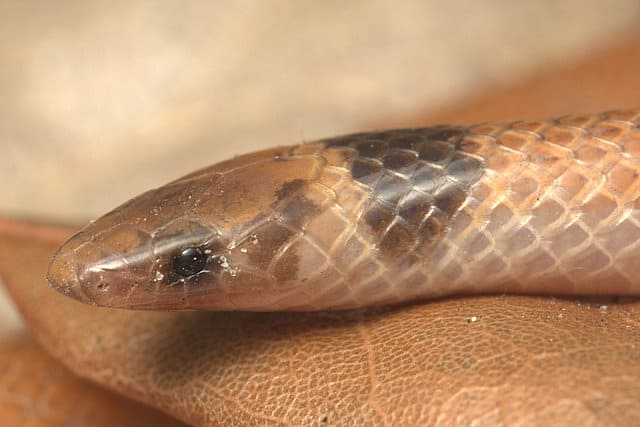
Florida crowned snakes are small snakes that prefer to live in sandy habitats.
©Alessandro Catenazzi / Creative Commons – Original / License
Similar to rim rock crowned snakes, Florida crowned snakes are about 7 to 9 inches long and are tan to reddish brown with a darker-colored head.
Eastern Ribbonsnake (Thamnophis saurita)
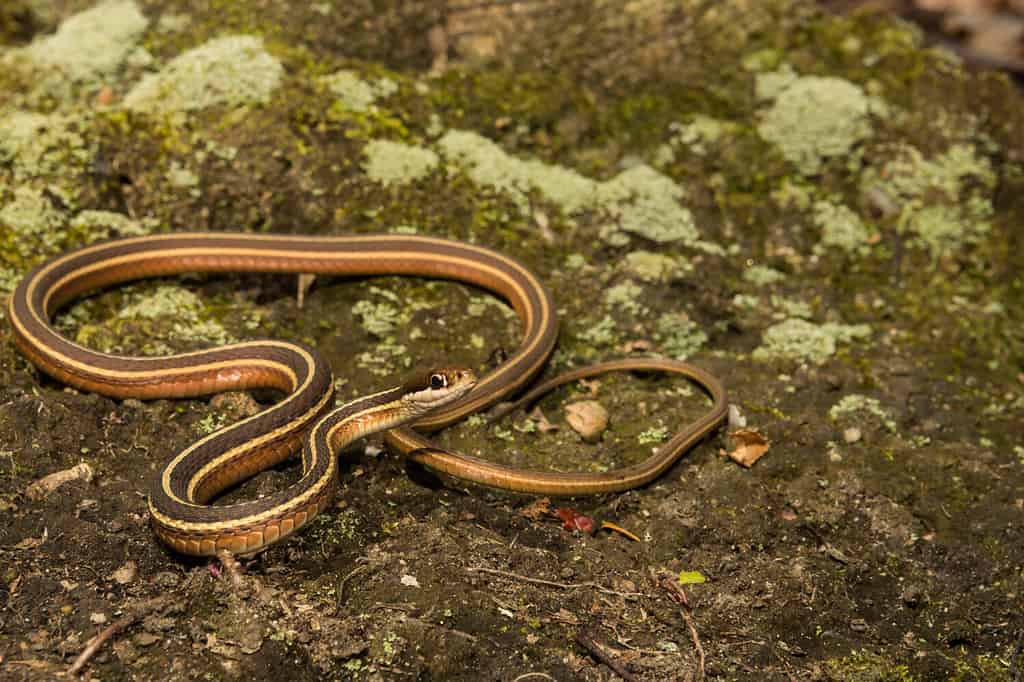
As its name suggests, the Eastern ribbonsnake is a long and slender snake.
©Jay Ondreicka/Shutterstock.com
The non-venomous Eastern ribbonsnake is a slender snake about 18 to 26 inches long. Many ribbonsnakes are brownish in color with long stripes that go up and down the length of their body. Ribbonsnakes are semi-aquatic and can be found living near bodies of water.
Common Gartersnake (Thamnophis sirtalis)

Like their name suggests, common gartersnakes are abundant across North America.
©Natalia Kuzmina/Shutterstock.com
Common gartersnakes are non-venomous, slender snakes around 18 to 26 inches long. They vary in color. Gartersnakes can be brown, tan, gray, or black.
Smooth Earthsnake (Virginia valeriae)
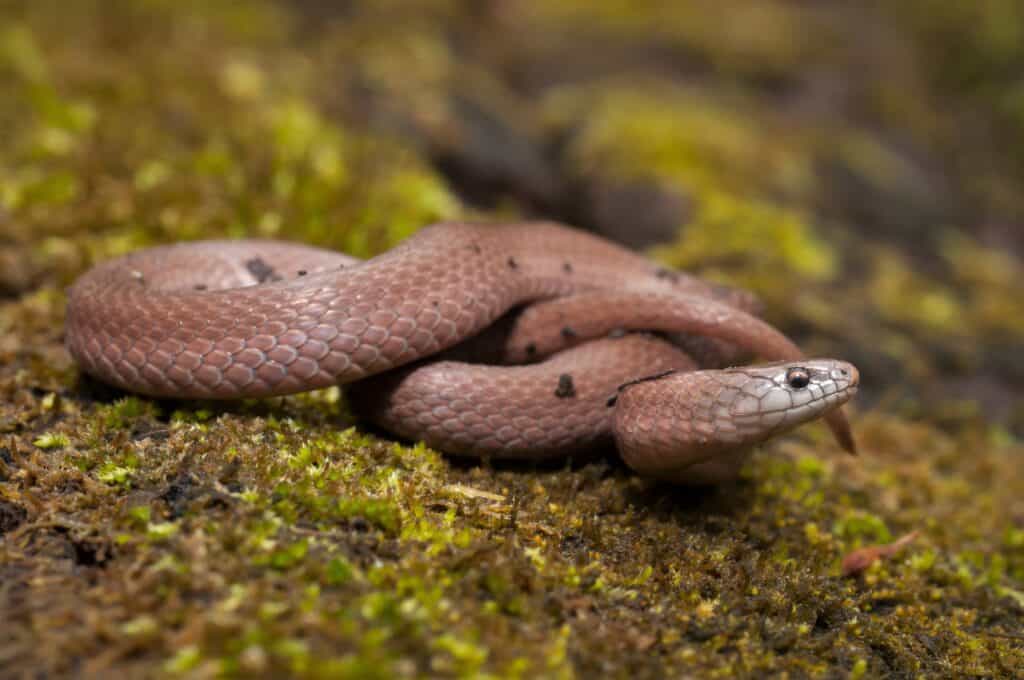
These small snakes help to keep insect populations in check.
©Mike Wilhelm/Shutterstock.com
Smooth earthsnakes have glossy scales and range in color from brown to reddish brown. They are small (7 to 10 inches long) and non-venomous.
The post All the Brown Snakes You Can Find in Florida appeared first on A-Z Animals.
November 14, 2025 at 06:02PMJennifer Geer
.jpeg)
.jpeg)

0 Comments